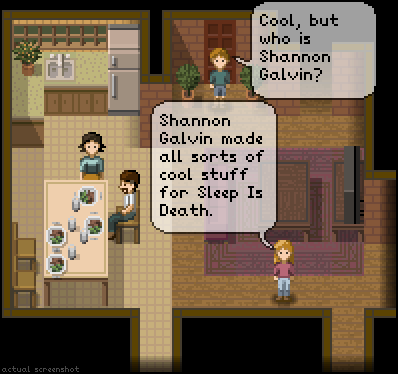It just doesn’t feel right trying to review something like Jason Rohrer’s Sleep Is Death. To me, that would be like trying to review Dungeons & Dragons, or campfire tales in general, or conversation — all of it. Sleep Is Death is more a game creation tool or storytelling platform than it is a single, critiquable entity; it is a sea of possibility limited almost solely by the people swimming in it. For this reason, it is more appropriate to approach Sleep Is Death in a discussion than in a review (and Rohrer did chat with me and the Big Red Potion crew a couple of weeks back), but I will still do my best to convey what this little piece of software is and why it’s both important and excellent.
Sleep Is Death is a game for two people, and is only a game at all when two people are involved (otherwise it functions as a storyboard creator). The more important role is that of the "controller": the storyteller, game master, or game director, who presents each session’s content in semi-real time. Via a simple gridded control panel interface, the controller customizes the game’s current background, music, objects, characters, dialogue, and narration, or selects from a number of pre-made items, available from the outset. The controller essentially builds a new game/story in every session. The "player," on the other hand, sees only a single window with three available actions per timed turn. The player may move anywhere on the screen, type anything into a speech bubble, and/or indicate with an arrowed box that he or she wishes to interact with something in the scene, again using any words that come to mind. It’s then up to the controller, in the next 30 seconds (a default setting that can be changed to anything, including the 300 seconds that I personally prefer to use), to respond to those actions with what would typically be stored in unalterable form on a game disc, but is instead dynamically generated by a real human brain.

For the player, Sleep Is Death is only what the controller can author and offer in any given local or remote game session using the tools available. For the controller, however, the game is a powerful design utility that can be used to tell incredibly varied, open-ended, and meaningful stories, and to create player-director interaction that is impossible in current single-player games and completely different from standard multiplayer experiences. With the support of a robust community at sites like www.sidtube.com, creative expression can be fueled with numerous downloadable "resource packs," which include any number of game assets created in Sleep Is Death‘s surprisingly capable and versatile scene, room, object, sprite, and music editors. Every game session also outputs a pictoral "flipbook" of the entire story once the controller decides to end it, and hundreds of these game records can be found online, as well. What SID players have put together and shared with the community is astonishing, and makes the game an ever-expandable product.
Sleep Is Death‘s primary fault is the steep difficulty curve it imposes on the controller. While Rohrer himself recommends not being overly ambitious to start with, perhaps beginning with a single-scene game and some solid dialogue, the potential is enticing enough to lead a controller to destroy his own game with unnecessary complexity. On the other hand, practice with the control panel and a reasonable time investment can lead a controller to create very impressive content; I’ve already seen pseudo-3D games, first-person games, dungeon crawlers, shooters, and even inventory management systems produced by members of the community to go along with the basic adventures SID is most obviously suited for.
Sleep Is Death brings the concept of the game back under the control of the players involved, at once combining the natural ease of conversation and storytelling with the self-contained, individually directed experiences offered by film and modern video games. It is about the people at the keyboard; their stories, their creativity, and their interactions are the real substance here. SID is but the medium of transport, and although it expects a high degree of openness and willingness of its users — which it may not always get; it’s not for everyone — it accomplishes its goals very admirably, and shows us at least one direction in which this industry can and should be moving.


















